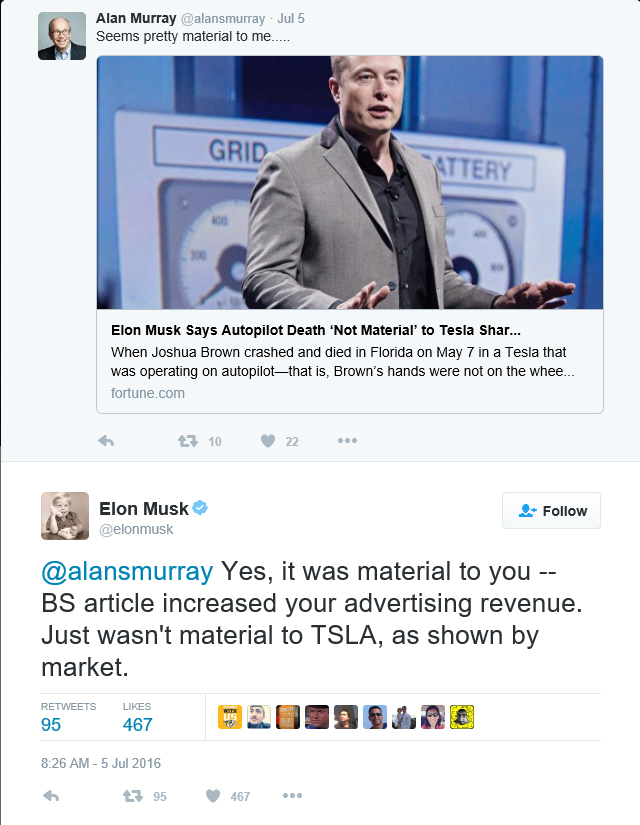Last week, news broke of the first fatal car crash involving a Tesla running in autopilot mode. But while the world only just learned about the accident, which killed a 40-year-old man in Florida, the accident itself occurred in May — a potentially material piece of information, first noted by Fortune’s Carol Loomis, that Tesla did not disclose to its investors at the time.
Given that a significant component of Tesla’s appeal is the potential safety benefits (and cool factor) of its highly touted autopilot system (which is still, remember, in beta mode), it’s at least worth asking why the company did not feel the need to tell investors and buyers about the Florida crash. Which is all that Loomis wanted to do when she began an email conversation with a Tesla PR exec.
And then Tesla founder Elon Musk himself got involved.
From Fortune:
Then Elon Musk himself suddenly entered the email conversation. He first thought, mistakenly, that Fortune was criticizing the price at which Tesla and he had sold stock. This writer replied that was not the case and that the issue was the non-disclosure of a material fact. That, Musk replied in a second e-mail, “is not material to the value of Tesla.”
He continued, “Indeed, if anyone bothered to do the math (obviously, you did not) they would realize that of the over 1M auto deaths per year worldwide, approximately half a million people would have been saved if the Tesla autopilot was universally available. Please, take 5 mins and do the bloody math before you write an article that misleads the public.”
Musk wasn’t done. When Fortune editor Alan Murray tweeted the story, Musk replied with another zinger, clearly displeased that the publication had run the story despite his impassioned pleas for bloody math.
The incensed-CEO-directly-contacting-reporters is a tech-industry trope dating back at least to Steve Jobs, who’d famously reply to personal emails with blunt answers to reporters. But what felt somewhat refreshing five years ago has become tiresome as Silicon Valley has emerged as an economic and political power to rival any other industry (or institution) on the planet. Musk’s not wrong — traditional cars and their traditional human drivers are likely a bigger danger than their self-driving counterparts — though, as a math teacher might say, show your work. But wildly flailing at reporters doing their jobs no longer feels like a democratic bypass of multiple layers of spin and publicity. Instead, it comes across as desperate and insecure: an immensely powerful man objecting to legitimate questions (on a holiday weekend, no less). The power imbalance between the tech industry and the media industry has become too glaring for CEO-versus-reporter tête-à-têtes to seem anything but pathetic.
And why would he respond, anyway? As a rep from Tesla’s PR team also pointed out to Fortune, after news of the crash broke last week, Tesla stock dropped only temporarily before rising back up to a price of $216 per share. A price $4 higher than the stock was before the Autopilot crash made headlines. The company (which Musk has claimed could be worth over $700 billion by 2025) wasn’t exactly hurting for money. And now, it’s not hurting for unnecessary bad press either.
Author: Madison Malone Kircher
